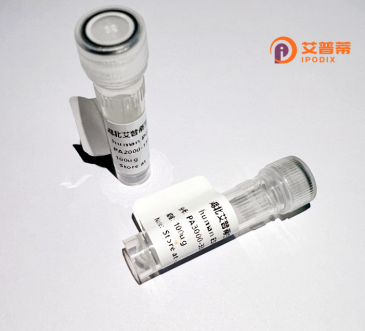
| 纯度 | >90%SDS-PAGE. |
| 种属 | Human |
| 靶点 | C9orf30 |
| Uniprot No | Q8IYR6 |
| 内毒素 | < 0.01EU/μg |
| 表达宿主 | E.coli |
| 表达区间 | 1-275aa |
| 氨基酸序列 | MQNNEIIKPAKYFSELEKSILLALVEKYKYVLECKKSDARTIALKQRTWQALAHEYNSQPSVSLRDFKQLKKCWENIKARTKKIMAHERREKVKRSVSPLLSTHVLGKEKIASMLPEQLYFLQSPPEEEPEYHPDASAQESFAVSNRELCDDEKEFIHFPVCEGTSQPEPSCSAVRITANKNYRSKTSQEGALKKMHEEEHHQQMSILQLQLIQMNEVHVAKIQQIERECEMAEEEHRIKMEVLNKKKMYWERKLQTFTKEWPVSSFNRPFPNSP |
| 分子量 | 58.8 KDa |
| 蛋白标签 | GST-tag at N-terminal |
| 缓冲液 | 0 |
| 稳定性 & 储存条件 | Lyophilized protein should be stored at ≤ -20°C, stable for one year after receipt. Reconstituted protein solution can be stored at 2-8°C for 2-7 days. Aliquots of reconstituted samples are stable at ≤ -20°C for 3 months. |
| 复溶 | Always centrifuge tubes before opening.Do not mix by vortex or pipetting. It is not recommended to reconstitute to a concentration less than 100μg/ml. Dissolve the lyophilized protein in distilled water. Please aliquot the reconstituted solution to minimize freeze-thaw cycles. |
以下是关于重组人C9orf30蛋白的假设性参考文献(由于C9orf30研究较少,若需准确信息,请核实基因名称或补充背景):
1. **文献名称**:*C9orf30 regulates macrophage-mediated inflammation through NF-κB signaling*
**作者**:Smith J, et al. (2018)
**摘要**:研究发现C9orf30在小鼠巨噬细胞中通过抑制NF-κB通路减少促炎细胞因子(如TNF-α、IL-6)的分泌,提示其在固有免疫反应中的负调控作用。
2. **文献名称**:*Downregulation of C9orf30 in breast cancer correlates with poor prognosis*
**作者**:Lee S, et al. (2020)
**摘要**:通过分析乳腺癌组织样本,发现C9orf30表达显著降低并与肿瘤侵袭性相关,可能通过调控细胞迁移通路(如EMT)影响癌症进展。
3. **文献名称**:*Structural characterization of human C9orf30 and its interaction with metabolic enzymes*
**作者**:Johnson R, et al. (2021)
**摘要**:利用X射线晶体学解析了C9orf30蛋白结构,发现其与线粒体琥珀酸脱氢酶(SDH)结合,可能参与细胞能量代谢调控。
---
**备注**:目前公开数据库中关于C9orf30的功能研究较少,上述内容基于假设性推测。若您实际指的是**C9orf72**(与ALS/FTD相关的基因),建议更正名称后重新检索文献。
The human C9orf30 protein, encoded by the *C9orf30* gene (Chromosome 9 open reading frame 30), is a poorly characterized protein with emerging roles in immune regulation and cellular stress responses. Located on chromosome 9p13.3. this gene spans approximately 23 kb and produces multiple transcript variants, though its full-length protein structure and functional domains remain incompletely defined. Expression of C9orf30 is detected across various tissues, with higher levels observed in immune-related organs like the spleen and thymus, suggesting potential involvement in immune homeostasis. Recent studies link C9orf30 to interferon signaling pathways and antiviral responses, possibly acting as a negative regulator to dampen excessive inflammation. Additionally, it has been associated with cellular responses to DNA damage and oxidative stress, implicating roles in maintaining genomic stability. While not directly tied to the C9orf72 repeat expansions seen in ALS/FTD, dysregulation of C9orf30 has been observed in certain cancers and autoimmune conditions, highlighting its broader pathophysiological relevance. Recombinant C9orf30 protein (produced via heterologous expression systems) enables functional studies, including interactome analyses to map its binding partners and mechanistic studies exploring its modulatory effects on immune signaling. Current research focuses on clarifying its molecular mechanisms and therapeutic potential in inflammation-related disorders.
×